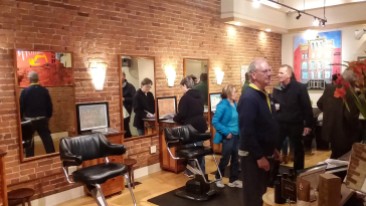At work in the Candystore
The show that wasn’t until fall
The Long Walk, the exhibition part of the Destination Venezuela series at the Vicksburg Cultural Arts Centre, now moved to the fall.
Pop-up in Vicksburg
This is an exhibition of my recent paintings @ Prairie Ronde Gallery, Vicksburg, alongside Cindy Steiler, Prairie Ronde artist-in-residence @ Vicksburg Cultural Arts Center.
Cranes, change and permanence on East Michigan Avenue
This exhibition of paintings included in the 2019 October Art Hop at Suzanne’s Organics Salon features the downtown Kalamazoo urban landscape; it juxtaposes elements from the vintage architecture and the ongoing metamorphosis with new construction going up on all sides. Continue reading “Cranes, change and permanence on East Michigan Avenue”
Project MAPEA in Child in the City seminar in Antwerp
As a visual artist it was something of a novelty to be attending an academic seminar broadly designed for architects, urban planners and other professionals from this area. But since our mapping project began in Caracas from involvement with youth and children in shantytown communities, when I saw the call for the Children in the Sustainable City Seminar it seemed the right place for our proposal.
This trip to Antwerp turned out be a stimulating and fruitful experience over the two-day meeting. Above all, it was so reassuring to find oneself talking the same language when it came to sharing experiences, it can get very frustrating trying to explain this multi-disciplinary workshop model even in the art world.
MAPEA has reached four editions in the last four years so it continues to grow and prove its validity. At this moment it seems more urgent than ever to bring this activity to children amid such violence, encouraging a conversation about the environment and developing tools with which to do so. My participation in the seminar was a way of continuing our work when the crisis in Venezuela frustrated this year’s plans. By the end of March, when I should have been travelling to Caracas, flights were cancelled and the possibility of achieving the results we hoped for seemed pretty remote. It was a heart-breaking decision to cancel the trip, and we continue to wait for a change in tide to resume our plans.

Continue reading “Project MAPEA in Child in the City seminar in Antwerp”
Cheo cuenta MAPEA
Talleres MAPEA en el Calvario y casco del Hatillo, Caracas 2018
Video de Andres Catalano
MAPEA: Natalya Critchley, Cheo Carvajal, Monica Santander, Yoandy Medina con el apoyo del Sr Jose Gonzalez y Carlos Barreto de la Co-operativa en el Calvario
Talleres con los estudiantes de 4to, 5to y 6to grado de las escuelas Maria May (el Calvario) y Juan Manuel Cajigal (en el casco del Hatillo)
Walking, mapping, opening doors
Connection Calvario-Hatillo town centre
An essential condition for a sustainable city is that it can be walked around comfortably and safely. That it should be accesible to all. Another is that it should be mixed, not only in it’s uses -residential, offices, public spaces and features-, but socially as well. Another condition? To achieve a balance with whatever natural features still exist: water courses, green spaces, trees, biological diversity. Even though it sounds obvious the air must be clean to be able to breath properly! But also in a metaphorical sense, what is on offer should be so diverse that you just want to be there, day or night. That ‘habitability’ leads us to an additional wish: it must be enjoyable.
Andar, mapear, abrir puertas
Andar, mapear, abrir puertas
Conexión El Calvario-Casco
Una condición indispensable para que la ciudad sea sustentable es que se pueda caminar de manera cómoda, segura. Que sea accesible para todos. Otra es que sea mezclada, no sólo en sus usos –residencias, comercios, oficinas, espacios y equipamientos públicos–, sino también socialmente. ¿Otra condición?, que logre un equilibrio con lo que ella todavía tiene de natural: cursos de agua, espacios verdes, arbolado, diversidad biológica. Aunque suene obvio hay que decirlo: ¡que se pueda respirar, que tenga aire limpio! Pero también en sentido metafórico: que la oferta sea tan diversa que den ganas de vivir en ella, de día y de noche. Esas “ganas de vivir en ella” nos lleva a un deseo adicional: que sea lúdica.
Continue reading “Andar, mapear, abrir puertas”
Papermill DNA
This pop-up exhibition is the result of my participation in the Prairie Ronde Artist Residency series here in Vicksburg, MI. The programme was established as part of the Papermill renovation project. The drawings were carried out both onsite at the mill, and in the Hills Pharmacy as the idea for the show was developed.

It was fascinating to finally visit a papermill building, I had already seen many in the area. In Parchment, Kalamazoo there is a huge abandoned factory that I was very curious about when I first saw it, but was warned it was difficult to get into and dangerous. Having been such an important industry in the region I was sure there must be an opportunity somewhere. So, on reading about this residency programme I could hardly contain my enthusiasm, and it was very rewarding to be admitted.
My initial reaction on visiting the mill was admiration for the early industrial architecture, as in the specialised designs for the work spaces required at the beginning of the last century, with so many windows to make the most of natural light. The beautiful wooden beam structure of the top floor of the East wing, which allows overhead light in through the roof with north facing windows, would make the perfect studio for any artist. And it goes to show the attention to detail for producing a high quality product, since it was here that the cotton rags were first sorted before washing and beating into pulp. Continue reading “Papermill DNA”














